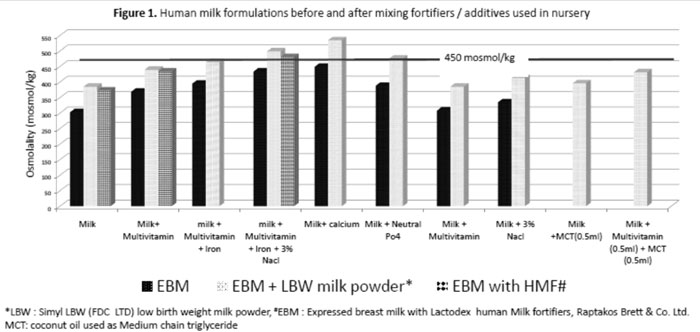|
|
|
Indian Pediatr 2016;53:
167-169 |
 |
Effect of Fortification and Additives on
Breast Milk Osmolality
|
|
Vijay Gupta, Victoria Job and *Niranjan Thomas
Department of Neonatology and Clinical Biochemistry,
Christian Medical College, Vellore, Tamil Nadu, India.
Email:
*[email protected]
|
|
This study evaluated the effect of
fortification and commonly used additives on the osmolality of human
milk. Osmolality after fortification with milk powder and human milk
fortifier increased from 303 mOsmol/kg to 397 and 373 mOsmol/kg,
respectively. The maximal increase in osmolality was seen with the
addition of calcium gluconate.
Keywords: Breastfeeding, Human milk fortifier,
Infant feeding.
|
|
Fortification of human milk is commonly used to
achieve adequate postnatal growth of preterm infants. This can be done
using either commercially available human milk fortifiers (HMF) or
infant milk powder [1]. Several studies have evaluated the effect of HMF
on osmolality of milk, but effect of infant milk powder and other
additives has not been adequately studied. Various additives like
calcium, iron and multivitamins may increase the osmolality beyond the
recommended levels (<450 mOsmol/kg) [2-4]. Increased osmolality of milk
has been associated with feed intolerance, delayed gut emptying and
necrotizing enterocolitis [3,5,6]. We evaluated the effect of different
combinations of fortification and commonly used additives on the
osmolality of preterm human milk.
The osmolality was measured with freezing point
depression method, using an osmometer (Osmomat 030 Germany). A
thermistor probe measured the difference in freezing point of the
solution measured from the reference. The instrument was regularly
calibrated and was checked with internal controls for each batch of
analysis of milk samples. Freshly expressed breast milk (EBM) was
obtained from four mothers (24- 28yrs old, normal nutritional status,
delivered at 32-34 weeks gestation) during their second week of
lactation after informed consent. The EBM was fortified by adding 1g HMF
or 1 g Infant milk powder to 25 mL of EBM. Osmolality was checked before
and after fortification, and also after addition of several nutrients
that are used commonly. This included coconut oil, multivitamin drops
(containing 1000IU Vitamin A, vitamin B complex, 40 mg vitamin C and
200IU vitamin D in each ml), 3% NaCl, calcium gluconate (9.3 mg/mL
elemental calcium), neutral phosphate (33 mg/mL elemental phosphate),
and colloidal iron drops (25 mg elemental iron, vitamin B 12
5 mcg, folic acid 200 mcg in each mL).
Fortification using milk powder and HMF increased
osmolality of EBM, from 303 mOsmol/kg to 397 and 373 mOsmol/kg,
respectively. Addition of additives led to a further increase in the
osmolality (Fig. 1). The increase in osmolality was
largest with addition of 10% calcium gluconate, and least with coconut
oil (Fig. 1). Though fortification or additives added
alone to unfortified milk did not increase the osmolality beyond 450
mOsml/kg, addition of these additives to fortified milk increased the
osmolality beyond this safe limit.
 |
|
Fig. 1. Osmolality of breast milk
with fortification and different combinations of additives.
|
The increase in osmolality of milk by addition of HMF
in our study was comparable to some earlier studies [7,8], but was less
than that observed by Kreissl, et al. [9], who also observed
marked increase in osmolality by addition of multivitamins, iron and
calcium along with HMF.
Addition of additives to fortified milk should be
done with caution as this may increase the osmolality of feeds beyond
the safe limit. It is important to make paediatricians aware that
fortification and additives increase the osmolality of milk which could
potentially lead to gut injury in preterm neonates.
Contributors: All authors were involved in
the concept, design and analysis of the study. The first draft was
prepared by VG and all authors were involved in the revision, and
approval of the final version of the manuscript.
Funding: None; Competing interests: None
stated.
References
1. Kuschel CA, Harding JE. Multicomponent fortified
human milk for promoting growthin preterm infants. Cochrane Database
Syst Rev. 2004;1:CD000343.
2. De Curtis M, Candusso M, Pieltain C, Rigo J.
Effect of fortification on the osmolalityof human milk. Arch Dis Child
Fetal Neonatal Ed. 1999;81:F141-3.
3. Janjindamai W, Chotsampancharoen T. Effect of
fortification on the osmolality ofhuman milk. J Med Assoc Thail
Chotmaihet Thangphaet. 2006;89:1400-3.
4. Commentary on breast-feeding and infant formulas,
including proposed standards forformulas. Pediatrics. 1976;57:278-85.
5. Pearson F, Johnson MJ, Leaf AA. Milk osmolality:
Does it matter? Arch Dis Child Fetal Neonatal Ed. 2013;98:F166-9.
6. Willis DM, Chabot J, Radde IC, Chance GW.
Unsuspected hyperosmolality of oralsolutions contributing to necrotizing
enterocolitis in very-low-birth-weight infants.Pediatrics. 1977;60:535-8.
7. Agarwal R, Singal A, Aggarwal R, Deorari AK, Paul
VK. Effect of fortification withhuman milk fortifier (HMF) and other
fortifying agents on the osmolality of pretermbreast milk. Indian
Pediatr. 2004;41:63-7.
8. Srinivasan L, Bokiniec R, King C, Weaver G,
Edwards AD. Increased osmolality ofbreast milk with therapeutic
additives. Arch Dis Child Fetal Neonatal Ed.2004;89:F514-7.
9. Kreissl A, Zwiauer V, Repa A, Binder C, Haninger
N, Jilma B, et al. Effect of fortifiers and additional protein on
the osmolarity of human milk: is it still safe for the premature infant?
J Pediatr Gastroenterol Nutr. 2013;57:432-7.
|
|
|
 |
|

